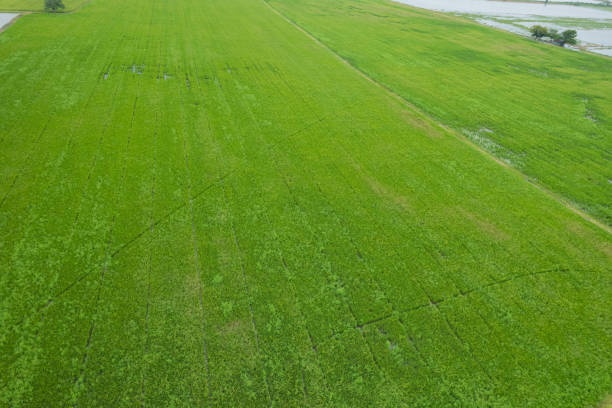
When it comes to agriculture, there are a multitude of risks that farmers face on a daily basis. From unpredictable weather patterns to pests and diseases, the livelihoods of farmers are constantly at stake. However, there is one crucial tool that serves as the backbone of the industry and helps to mitigate these risks: crop insurance. This form of protection provides financial and cultivating security for farmers in the event of crop failures or other unforeseen circumstances. In this blog post, we will explore the importance of crop insurance and how it saves farms from potential devastation.
Understanding the Fundamentals of Crop Insurance and Cultivating Security
Crop insurance is a critical component of the agriculture industry, providing farmers with financial security and peace of mind in the face of potential crop failures and other unforeseen circumstances. Understanding the fundamentals of crop insurance is essential for farmers to make informed decisions about protecting their livelihoods.
At its core, crop insurance is a risk management tool that helps farmers protect against the uncertainties of farming. It provides coverage for a variety of potential losses, including damage caused by adverse weather conditions, pests, diseases, and even market fluctuations. By transferring the risk to the insurance company, farmers can mitigate their financial losses and ensure their operations can continue even in the face of adversity.
The process of obtaining crop insurance involves several key steps. Farmers first need to identify the specific risks they face and determine the appropriate coverage options for their needs. This includes assessing factors such as the types of crops they grow, the potential yield and revenue, and the historical performance of their farm. Farmers then work with insurance agents or brokers to select a policy that meets their requirements and budget.
Premiums for crop insurance are typically subsidized by the government, making it more accessible and affordable for farmers. The amount of coverage provided by the insurance policy depends on various factors, including the chosen coverage level, the farm’s production history, and the specific crop being insured.
By understanding the fundamentals of crop insurance, farmers can better navigate the complexities of the industry and make informed decisions to protect their investments. With this valuable tool, they can cultivate security and safeguard their farms against the risks that are an inherent part of agriculture.

Unraveling the Importance of Crop Insurance Cultivating Security for Sustainable Agriculture
When it comes to sustainable agriculture, crop insurance plays a vital role in ensuring the long-term viability of farms. With climate change, unpredictable weather patterns, and increasing pest and disease pressures, farmers face significant challenges in maintaining a sustainable operation. Crop insurance is a powerful tool that helps farmers mitigate these risks and continue to provide food for our growing population.
One of the key reasons why crop insurance is important for sustainable agriculture is its ability to protect farmers’ investments. By providing financial security in the event of crop failures or other unforeseen circumstances, crop insurance enables farmers to recover and continue their operations. This stability is crucial for the long-term sustainability of farms, as it allows them to invest in new technologies, practices, and equipment that can enhance their productivity and efficiency.
Crop insurance also promotes environmental sustainability by incentivizing farmers to adopt more resilient and sustainable farming practices. When farmers have the assurance that they will be compensated for losses, they are more likely to invest in conservation measures, such as soil conservation, water management, and biodiversity protection. These practices not only reduce the risks of crop failure but also contribute to the overall health and resilience of the agroecosystem.
Furthermore, crop insurance helps ensure the availability of affordable and nutritious food for consumers. When farmers are protected against significant financial losses, they can maintain stable production levels and avoid drastic price increases. This stability in food production and prices is critical for food security, particularly in a world where population growth and climate change are putting increased pressure on the agricultural sector.

Real-Life Stories: How Crop Insurance Cultivating Security Has Saved Farms
Crop insurance is not just a theoretical concept – it has proven to be a lifeline for many farmers facing adversity. Real-life stories showcase the importance of crop insurance and how it has saved farms from potential devastation. These stories highlight the invaluable role that this form of protection plays in ensuring the survival and success of agricultural operations.
One such story comes from John, a fourth-generation farmer in the Midwest. Last year, a severe drought hit his region, causing widespread crop failures. John had invested heavily in his corn and soybean crops, and the prospect of losing everything was devastating. However, thanks to his comprehensive crop insurance policy, John was able to recoup a significant portion of his losses and continue his farming operation. Without crop insurance, he would have been forced to shut down his farm and face financial ruin.
In another instance, Sarah, a small-scale organic farmer, experienced a sudden outbreak of a destructive pest that decimated her vegetable crops. With the help of her crop insurance, she was able to recover financially and replant her fields. This enabled her to maintain her commitment to sustainable farming practices and continue supplying her community with fresh, organic produce.
These stories, and countless others like them, demonstrate the critical role that crop insurance plays in protecting the livelihoods of farmers. Without this essential tool, many farms would not be able to recover from unforeseen events, such as weather disasters, pests, or market fluctuations. Crop insurance provides the financial security needed to weather these storms and ensure the long-term sustainability of farms.

Analyzing The Relationship Between Crop Insurance, Farm Security and Cultivating Security
Crop insurance serves as a critical tool for ensuring the security and stability of farms. By mitigating financial risks associated with crop failures and unforeseen circumstances, crop insurance plays a vital role in maintaining the overall security of the agricultural sector.
The relationship between crop insurance and farm security is multifaceted. Firstly, crop insurance provides farmers with a safety net that allows them to recover from significant financial losses. When farmers face events such as extreme weather conditions, pests, or market fluctuations, the insurance coverage provides them with the necessary funds to continue their operations. This stability not only protects farmers’ livelihoods but also ensures the availability of essential crops for consumers.
Furthermore, crop insurance contributes to the long-term security of farms by encouraging sustainable practices. When farmers have the assurance that they will be compensated for losses, they are more willing to invest in measures that enhance the resilience and productivity of their farms. This includes implementing conservation practices, adopting innovative technologies, and improving farm management techniques. These efforts contribute to the overall sustainability of the agricultural industry and protect against future risks.
The relationship between crop insurance and farm security is a symbiotic one. As farms become more secure, the agricultural sector as a whole benefits from increased stability and productivity. This, in turn, leads to food security, as a reliable and abundant food supply is essential for the well-being of societies.

Crop Insurance Policies – Ensuring Food Security and Livelihood
Crop insurance policies play a crucial role in ensuring food security and protecting the livelihoods of farmers. With the increasing uncertainties of climate change, unpredictable weather patterns, and the ever-present threat of pests and diseases, crop insurance provides a safety net for farmers, enabling them to continue producing the food that sustains our communities.
One of the key benefits of crop insurance policies is their ability to stabilize food prices. When farmers are protected against significant financial losses, they can maintain stable production levels and avoid drastic price increases. This stability is crucial for ensuring that nutritious and affordable food is accessible to all, even in times of crisis.
Crop insurance policies also provide financial security for farmers, allowing them to recover from unexpected losses and continue their farming operations. Whether it’s a crop failure due to extreme weather or a sudden outbreak of pests, the insurance coverage provides the necessary funds to replant, recover, and carry on. This security is vital for the long-term sustainability of farms, as it enables farmers to invest in new technologies, equipment, and practices that enhance their productivity and efficiency.
Furthermore, crop insurance policies promote the adoption of sustainable farming practices. When farmers know that they will be compensated for losses, they are more likely to invest in conservation measures, such as soil conservation, water management, and biodiversity protection. These practices not only reduce the risks of crop failure but also contribute to the overall health and resilience of the agroecosystem, ensuring the long-term viability of our food production systems.

Future Perspectives: Adapting Crop Insurance for Changing Climate Conditions
With the increasing impacts of climate change, it is clear that crop insurance policies will need to adapt to the changing climate conditions. Rising temperatures, changing rainfall patterns, and more frequent extreme weather events pose significant challenges to farmers and the agricultural industry as a whole. As such, future perspectives on crop insurance must consider the need for more comprehensive coverage and innovative solutions to protect farms against these new risks.
One potential avenue for adapting crop insurance to changing climate conditions is through the inclusion of coverage for climate-related risks. This could involve expanding coverage options to include losses due to drought, floods, heatwaves, or other extreme weather events that are becoming more frequent and intense. By specifically addressing these climate-related risks, crop insurance can better support farmers in mitigating the impacts of climate change on their operations.
Another aspect to consider in the future of crop insurance is the incorporation of advanced technology and data-driven models. With the rise of precision agriculture and remote sensing technologies, farmers now have access to a wealth of data that can inform decision-making and risk management. Crop insurance policies can leverage this data to offer more accurate coverage options, tailored to the specific needs and risks faced by individual farmers. By integrating technology and data into crop insurance policies, farmers can better understand their risks, optimize their practices, and receive more accurate compensation for losses.
Additionally, collaboration between insurance companies, government agencies, and agricultural organizations will be crucial in adapting crop insurance for changing climate conditions. By working together, these stakeholders can identify emerging risks, develop innovative coverage options, and provide farmers with the tools they need to adapt to a changing climate. This collaboration can also facilitate the exchange of knowledge and best practices, allowing farmers to learn from each other’s experiences and improve their resilience to climate-related challenges.
In conclusion, the future of crop insurance lies in its ability to adapt to changing climate conditions. By expanding coverage options, integrating advanced technology and data-driven models, and fostering collaboration, crop insurance can continue to be a crucial tool in safeguarding farms against the risks of a changing climate. Through these future perspectives, farmers can cultivate security and ensure the long-term sustainability of their operations in the face of a rapidly changing world.






Agriculture insurance and farmer protection gives high level of production